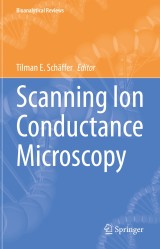Details

Scanning Ion Conductance Microscopy
Bioanalytical Reviews, Band 3
|
213,99 € |
|
| Verlag: | Springer |
| Format: | |
| Veröffentl.: | 28.09.2022 |
| ISBN/EAN: | 9783031144431 |
| Sprache: | englisch |
Dieses eBook enthält ein Wasserzeichen.
Beschreibungen
<p>This book provides a selection of recent developments in scanning ion conductance microscopy (SICM) technology and applications. In recent years, SICM has been applied in an ever-increasing number of areas in the bioanalytical sciences. SICM is based on an electrolyte-filled nanopipette with a nanometer-scale opening, over which an electric potential is applied. The induced ion current is measured, which allows to directly or indirectly quantify various physical quantities such as pipette-sample distance, ion concentration, sample elastic modulus among many others. This makes SICM well suited for applications in electrolytes - most prominently for the study of live cells.</p><p>This book starts with a historic overview starting from the days of the invention of SICM by Paul Hansma at the University of California at Santa Barbara in 1989. SICM is a member of the family of scanning probe microscopies. It is related to another prominent member of the family, atomic force microscopy (AFM), which has found application in almost any field of nanoscale science. The advantages and disadvantages of SICM over AFM are also outlined. One of the most effective and break-through applications of SICM nanopipettes is in electrochemistry. The different routes and applications for doing electrochemistry using nanopipettes are also discussed. In addition the book highlights the ability of SICM for surface positioning with nanometer precision to open up new vistas in patch clamp measurements subcellular structures. Finally the book presents one research area where SICM has been making a lot of contributions, cardiac research and the endeavors to combine SICM with super-resolution optical microscopy for highest-resolution joint topography and functional imaging.</p><p></p>
<p>The evolution of scanning ion conductance microscopy.- Scanning ion conductance microscopy and atomic force microscopy: A comparison of strengths and limitations for biological investigations.- Ions and electrons with scanning ion conductance microscopy.- Ion channel recording with a smart patch-clamp system.- Understanding cardiac structure and function at nanoscale resolution with SICM.- Local Electrochemical Characterization using Scanning Electrochemical Cell Microscopy.- Comparison of scanning ion conductance microscopy with scanning electron microscopy for imaging cells and tissues.- Correlating scanning ion conductance and super-resolved fluorescence microscopy.</p>
<b></b><b>Tilman E. Schäffer </b>studied physics in Heidelberg (Germany), Miami (USA), and Santa Barbara (USA). From the University of California at Santa Barbara (UCSB) he obtained a Master’s degree in 1996 and a Ph.D. degree in 1998, based on studies of the biomineralization of abalone nacre. As a postdoc at UCSB, he then researched a mechanism that nature uses to make strong and tough organic adhesives and fibers. In 1999 he became a group leader at the Max Planck Institute for Biophysical Chemistry in Göttingen, where he investigated dynamic protein-DNA interactions. From 2002 to 2007 he worked at the University of Münster on nanotechnological methods in brain research and completed his <i>Habilitation</i> in physics. In 2007 he became Professor of Applied Physics at the University of Erlangen-Nuremberg. He has been a Professor of Physics/Medical Technology at the University of Tübingen since 2011. His research focuses on the mechanics and dynamics of living cells, for whichhe develops and applies methods of scanning probe microscopy.
<p>This book provides a selection of recent developments in scanning ion conductance microscopy (SICM) technology and applications. In recent years, SICM has been applied in an ever-increasing number of areas in the bioanalytical sciences. SICM is based on an electrolyte-filled nanopipette with a nanometer-scale opening, over which an electric potential is applied. The induced ion current is measured, which allows to directly or indirectly quantify various physical quantities such as pipette-sample distance, ion concentration, sample elastic modulus among many others. This makes SICM well suited for applications in electrolytes - most prominently for the study of live cells.</p><p>This book starts with a historic overview starting from the days of the invention of SICM by Paul Hansma at the University of California at Santa Barbara in 1989. SICM is a member of the family of scanning probe microscopies. It is related to another prominent member of the family, atomic force microscopy (AFM), which has found application in almost any field of nanoscale science. The advantages and disadvantages of SICM over AFM are also outlined. One of the most effective and break-through applications of SICM nanopipettes is in electrochemistry. The different routes and applications for doing electrochemistry using nanopipettes are also discussed. In addition the book highlights the ability of SICM for surface positioning with nanometer precision to open up new vistas in patch clamp measurements subcellular structures. Finally the book presents one research area where SICM has been making a lot of contributions, cardiac research and the endeavors to combine SICM with super-resolution optical microscopy for highest-resolution joint topography and functional imaging.</p>
Overview of hot topics in scanning ion conductance microscopy (SICM) Presents recent applications of SICM and advantages over other techniques Multi-authored volume with contributions from experts in the field
Diese Produkte könnten Sie auch interessieren:

Verbesserung des Wissensmanagements in der manuellen Montage durch Einsatz eines Anreizsystems

von: Robin Dennis Sochor

59,99 €
















